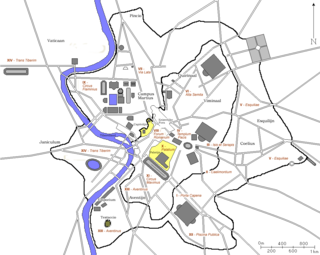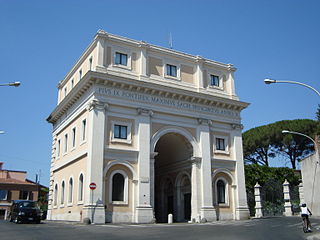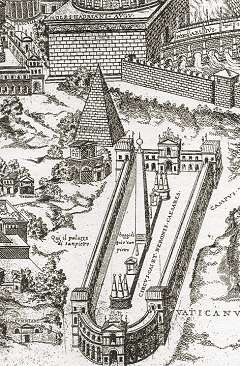
The Forma Urbis Romae or Severan Marble Plan is a massive marble map of ancient Rome, created under the emperor Septimius Severus between 203 and 211 CE. Matteo Cadario gives specific years of 205–208, noting that the map was based on property records.

In 7 BC, Augustus divided the city of Rome into 14 administrative regions. These replaced the four regiones—or "quarters"—traditionally attributed to Servius Tullius, sixth king of Rome. They were further divided into official neighborhoods.

As the home of the Pope and the Catholic curia, as well as the locus of many sites and relics of veneration related to apostles, saints and Christian martyrs, Rome had long been a destination for pilgrims. The Via Francigena was an ancient pilgrim route between England and Rome. It was customary to end the pilgrimage with a visit to the tombs of Saints Peter and Paul. Periodically, some were moved to travel to Rome for the spiritual benefits accrued during a Jubilee. These indulgences sometimes required a visit to a specific church or churches. Pilgrims need not visit each church.

Giovanni Battista (Carlo) de Rossi was an Italian archaeologist, famous even outside his field for rediscovering early Christian catacombs.
The Codex Vindobonensis 795 is a 9th-century manuscript, most likely compiled in 798 or shortly thereafter. It contains letters and treatises by Alcuin, including a discussion of the Gothic alphabet. It also contains a description of the Old English runes.

Porta San Pancrazio is one of the southern gates of the Aurelian walls in Rome, Italy.
De aquaeductu is a two-book official report given to the emperor Nerva or Trajan on the state of the aqueducts of Rome, and was written by Sextus Julius Frontinus at the end of the 1st century AD. It is also known as De Aquis or De Aqueductibus Urbis Romae. It is the earliest official report of an investigation made by a distinguished citizen on Roman engineering works to have survived. Frontinus had been appointed Water Commissioner by the emperor Nerva in AD 96.

The Liber Censuum Romanæ Ecclesiæ is an eighteen-volume (originally) financial record of the real estate revenues of the papacy from 492 to 1192. The span of the record includes the creation of the Apostolic Camera and the effects of the Gregorian Reform. The work constitutes the "latest and most authoritative of a series of attempts, starting in the eleventh century, to keep an accurate record of the financial claims of the Roman church". According to historian J. Rousset de Pina, the book was "the most effective instrument and [...] the most significant document of ecclesiastical centralization" in the central Middle Ages.
De mirabilibus urbis Romae, preserved in a single manuscript in Cambridge, England, is a medieval guide in Latin to the splendours of Rome, which was written in the mid-twelfth century by a certain Magister Gregorius of Oxford. The outlook here is even more secular than the Mirabilia urbis Romae, Roberto Weiss noted. Gregorius spent much of his time describing and even measuring the Roman ruins, and, according to Erwin Panofsky "had yielded so thoroughly to the 'magic spell' of a beautiful Venus statue that he felt compelled to visit it time and again in spite of its considerable distance from his lodgings". Magister Gregorius is the first to take notice of the Roman bronze called the "Spinario", then among ancient bronzes at the Lateran. Panofsky included Magister Gregorius's little book among examples of the reawakening of interest in classical antiquities evinced by a handful of connoisseurs in twelfth-century Rome. Still, like most of his contemporaries raised in familiarity with the Gothic hand, the unfamiliar Roman letters in inscriptions sometimes eluded his translation.

The Pons Neronianus or Bridge of Nero was an ancient bridge in Rome built during the reign of the emperors Caligula or Nero to connect the western part of the Campus Martius with the Ager Vaticanus, where the Imperial Family owned land along the Via Cornelia.
Francesco Albertini was a canon of the Basilica of San Lorenzo in Florence and a chaplain of Cardinal Fazio Santoro in Rome. In 1510 he wrote three books: The Opusculum de mirabilibus novae & veteris urbis Romae, the Septem mirabilia orbis et urbis Romae et Florentinae and the Memoriale di molte picture e statue sono nella inclyta cipta di Florentia.

The topography of ancient Rome is the description of the built environment of the city of ancient Rome. It is a multidisciplinary field of study that draws on archaeology, epigraphy, cartography and philology. The word 'topography' here has its older sense of a description of a place, now often considered to be local history, rather than its usual modern meaning, the study of landforms.
The Lexicon Topographicum Urbis Romae (1993–2000) is a six-volume, multilingual reference work considered to be the major, modern work covering the topography of ancient Rome. The editor is Eva Margareta Steinby, and the publisher is Edizioni Quasar of Rome. It is considered the successor to Platner and Ashby's A Topographical Dictionary of Ancient Rome.
Italica Press was founded in New York in 1985 by Eileen Gardiner and Ronald G. Musto. The press, now in its fourth decade, publishes English translations of works from the Middle Ages and Renaissance and English translations of contemporary Italian literature. It also publishes essays and collected essays in the study of art and history. It specializes in urban studies, medieval pilgrimage, medieval romances and chansons de geste, women writers, fiction, poetry, short stories and plays.

Peter Geoffrey Barry Hicks is a British historian and church musician.

The Meta Romuli was a pyramid built in ancient Rome that is important for historical, religious and architectural reasons. By the 16th century, it was almost completely demolished.

The Terebinth of Nero was a mausoleum built in ancient Rome that is important for historical, religious and architectural reasons. By the 14th century, it was almost completely demolished.

The Theatre of Nero was the private theatre erected in Rome by Nero, the Roman emperor between AD 53 and AD 68.












